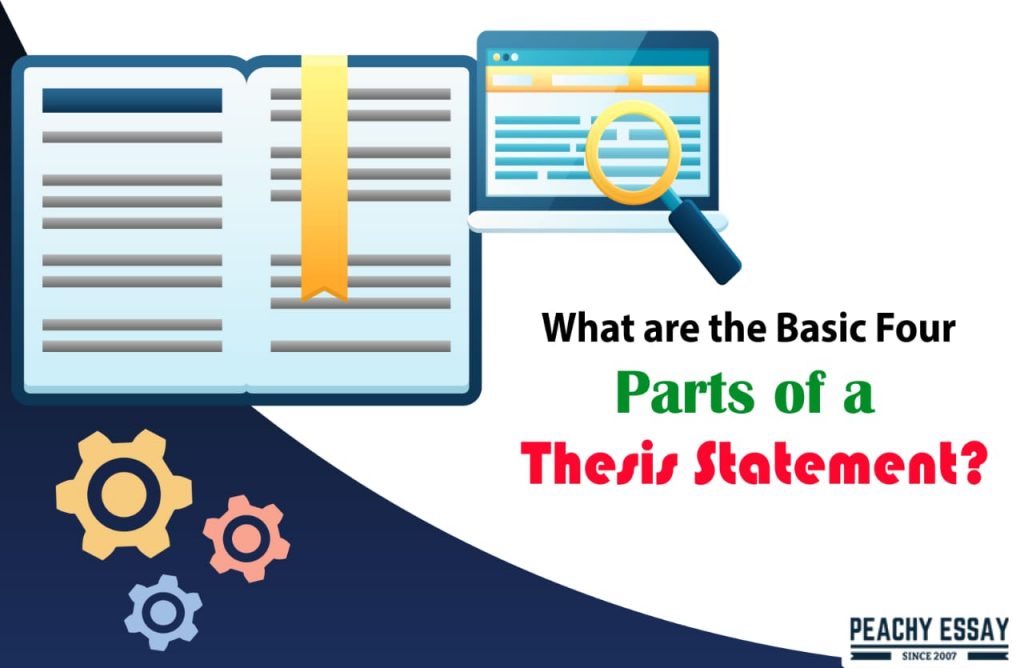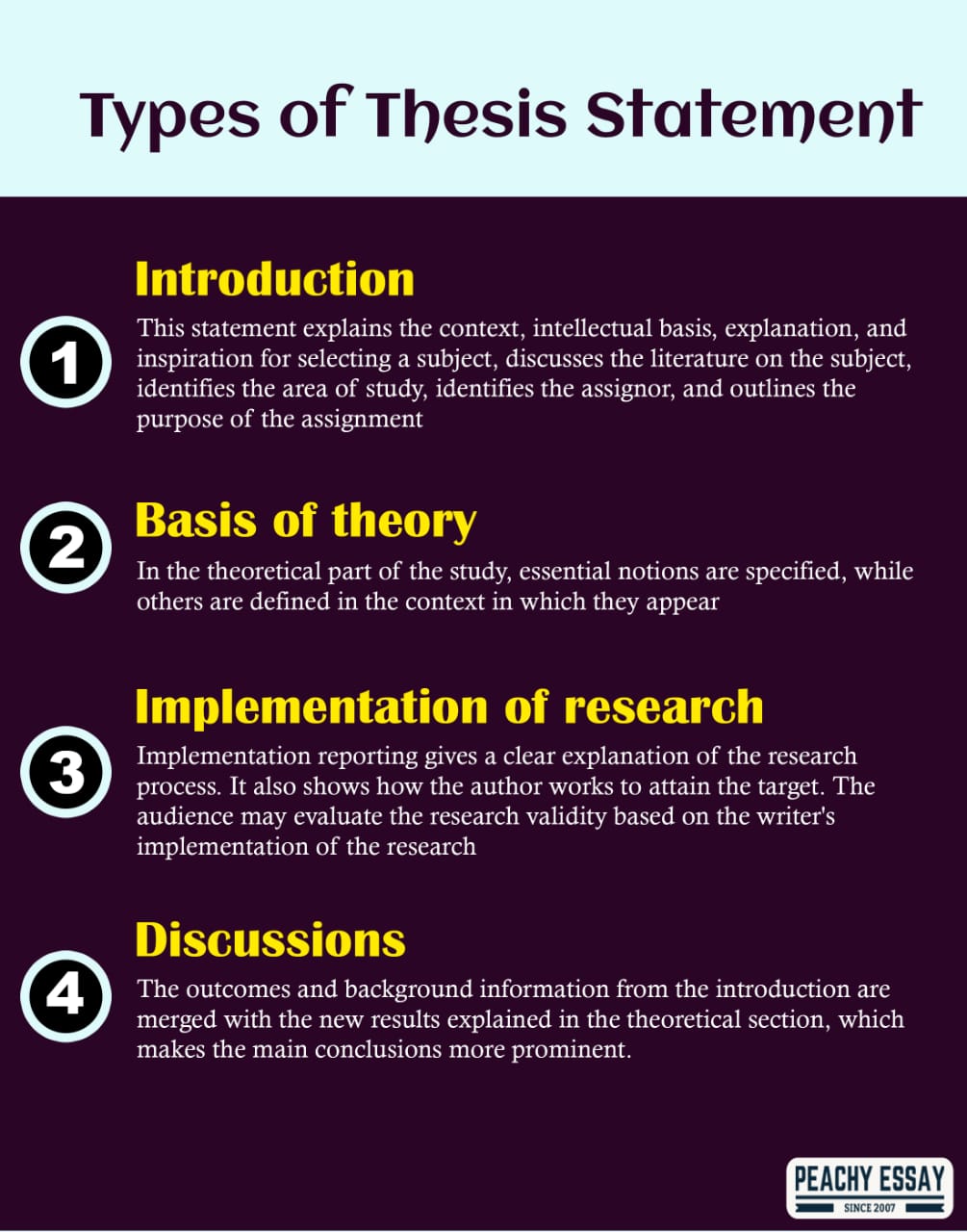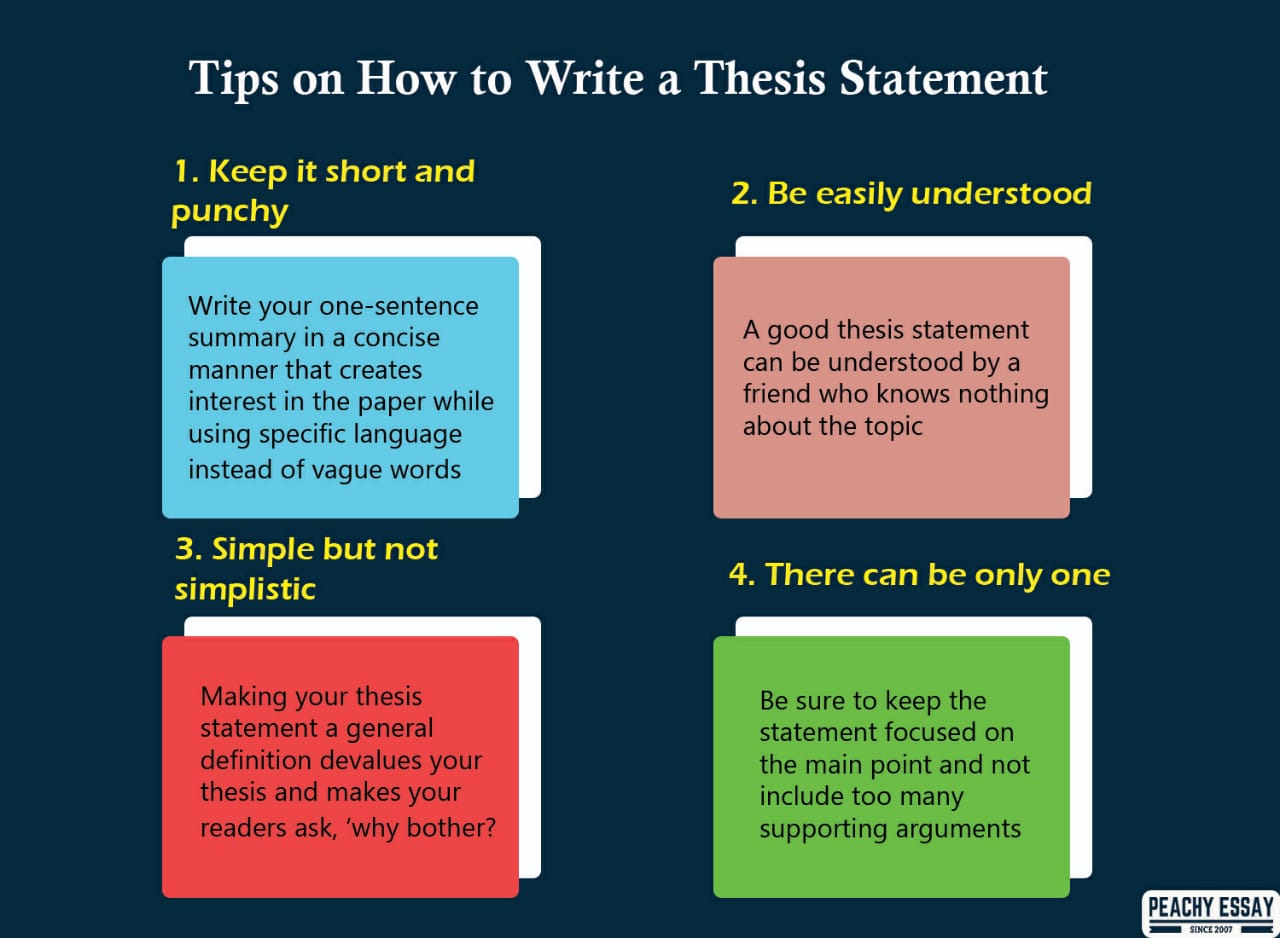Writing a good thesis statement requires thorough research and time. This one sentence can make or break your writing project. There are four parts to a thesis statement, which you should include in your paper.
The purpose of academic writing is to demonstrate the quality of your analysis, insight, and ideas. It shows that you know the concepts and that you have studied them. As an outcome of your evaluation, you can think about the concepts in your way, accept and oppose, or develop your particular ideas. Your thesis statement is the single sentence that describes what you believe since it presents your main arguments and insights clearly.
What is a Thesis Statement?
A thesis statement is a short statement, usually a sentence that explains or highlights the main point of an essay, research paper, etc., and is often supported by examples and facts.
Typically the thesis statement is presented in the first paragraph of your dissertation. The thesis contains the core idea of your paper and controls and organizes all the other parts.
Types of Thesis Statements
There are two types of thesis statements. One is argumentative, the other explanatory.
Argumentative thesis
An argumentative thesis is typically made up of one or two sentences. It states the writer’s stance and position. It should present the idea on which the essay is based.
Here’s an example to help you understand the argumentative thesis:-
BBC News is the best news channel on TV.
There are no debatable points in this sentence, so it is not an argumentative thesis statement.
It should be forbidden for TV channels to manipulate the news in any manner.
It is a specific thesis statement because the author is giving his opinion on a certain point. He believes the channel must report the news in its original way.
Explanatory Thesis
The purpose of an explanatory thesis is to search for and describe the characteristics of a particular subject. You can examine this subject for a long time, so the thesis announcement has to express this.
We can understand the explanatory thesis better with an example:-
There is a continuous decline in GDP.
This is not an appropriate explanatory thesis statement as it just states the fact without providing any reasons as to why it occurred.
The high cost of housing, insufficient housing support, and the desire to live in nuclear families are the main causes of homelessness.
The writer details and explains the reasons behind the problem well to make it an explanatory thesis statement.
The Main Four Parts of a Thesis Statement
There are four parts to a bachelor’s or master’s thesis (main part).
Accordingly, the way the study’s text is written can be modified based on the nature of the author’s work, whether it is a research-type article, a construction project, or a qualitative review.
- Introduction
The introduction familiarizes the audience with the subject of the thesis and piques their interest in it. This statement explains the context, intellectual basis, explanation, and inspiration for selecting a subject, discusses the literature on the subject, identifies the area of study, identifies the assignor, and outlines the purpose of the assignment. A description of the topic, its relevance in professional life, and its significance for the author can be found here.
- Basis of theory
Master’s or bachelor’s thesis theoretical frameworks define the goal of the degree project, along with an overview of the development and research activities involved. The theoretical basis should be in theory.
In the absence of a theoretical basis, the subject’s history should be discovered and a theory formulated. Its subject matter and nature will depend upon the method used and to what extent the phenomenon was examined.
After the author’s study, the theoretical basis is derived from data and then synthesized. He draws upon prior research, his professional experience, literature, and intuition. There is the possibility to present observations from the past combined with a description of the reliability, overall significance, and connections between previous work and current work. The data collected is presented objectively by dealing with comparisons and the results.
In the theoretical part of the study, essential notions are specified, while others are defined in the context in which they appear.
- Implementation of research
The author’s steps in implementing their research involve some arguments and must be described correctly. Implementation reporting gives a clear explanation of the research process. It also shows how the author works to attain the target. The audience may evaluate the research validity based on the writer’s implementation of the research.
An objective report displays the intent of the thesis, the methods of data collection, the author’s method of conducting the research, the material used, and how it was used. Besides describing the target audience for the study, it evaluates the legitimacy of the results with justifications.
From the four parts of a thesis statement, the most crucial one is its presentation of the research findings. Findings and results may not look the same, but both provide solutions to the research question.
The results of a research project can be judged in several ways depending on the problem addressed. A thesis statement’s structure, coupled with the research’s nature, determines how the results will emerge. Whenever the results are presented, one should always explain the goals of the thesis.
- Discussions
In the discussion, the outcomes and background information from the introduction are merged with the new results explained in the theoretical section, which makes the main conclusions more prominent.
Discussions provide a deeper insight into the writing area, as enhanced after the information gathered while putting together the master’s thesis. The writer’s findings should be compared with those mentioned earlier. Their arguments ought to be analyzed concerning their differences and similarities.
These findings give greater clarity to how the master’s or bachelor’s thesis has changed or enhanced knowledge in the field. Furthermore, the success of a thesis depends on the study and the practical application of its ideas.
What are the Most Common Mistakes of a Thesis Statement?
After you know the basics of thesis statement writing, there are certain errors that you should avoid. Identifying these errors and learning how to avoid them will help you to write a strong thesis statement.
Here are the thesis statement’s common mistakes.
The unclear statement
Your audience needs to comprehend your objective immediately. If it seems unclear or vague, you’ll lose them from the outset. Stay focused and use straightforward language to declare your main idea.
The complicated statement
A wordy statement and too long will frustrate readers and weaken the points you are trying to make.
The too basic statement
As you get older, you should prepare your work with more maturity. A solid thesis statement must include the main points. While being very straightforward in younger writing may be ok, older students must be more specific and refined.
The real purpose of the statement must be clear
Your audience must consider the topic in various ways. Does it provide useful data, help? Is it worthwhile to study? If not, then it is better to pick another topic that might be more captivating.
The statement includes bad use of words
There is no point in abbreviating, using slang, or using poor spellings to address a straightforward assertion of the thesis. To address, use technical terms.
The argument lacks reference to the rest of the writing
Even if you have a good thesis point, if the rest of the paper strays from your main claim, then it won’t matter. It would help if you always link your thoughts to the statement of your thesis. The paper must be cohesive and stays on track with its original theme.
What are the Four Qualities of a Good Thesis Statement?
Your essay must contain a central idea. This idea must come from a chosen topic or result from a question your teacher recently asked. If you discuss a topic in detail or answer a yes or no question, that is not enough. The main idea has to be formed when you form an opinion, and this idea is the one upon which your thesis is constructed.
Your thesis is your interpretation of a question or subject, not the topic itself. If your professor assigns you any topic at all, you must ask yourself what you intend to say about it. By answering this question, you will develop a thesis that is clear, convincing, and persuasive.
The thesis is usually one sentence long and appears at the end of your introduction. It mentions one to three key points of your piece—points that can be demonstrated in the body of your paper. It presents your plan for the essay and helps you get organized. Remember that a thesis statement does not summarize an issue but rather dissects it.
A strong thesis statement has the following qualities.
- Specificity: As you may recall, thesis statements begin when you choose a general topic and then narrow it down until you pinpoint a specific aspect of that topic. For example, health care is a broad topic. Still, a proper thesis statement would focus on the specific area of that topic, such as options for individuals without health care coverage.
- Precision: For a strong thesis statement to be precise and stay focused on the topic, it must make an exact claim about it. For example, your thesis statement should state that limited options exist only for uninsured individuals. There is more to discuss these limited effects, such as who they affect and how they arise.
- Ability to be argued: The thesis statement should present a clear argument. A statement of fact may not be considered arguable. Recheck your thesis statement to make sure your statement is supported by evidence.
- Ability to be demonstrated: If your thesis declares something, you need to indicate the reasons and examples for your assertion. You can either rely on personal observations or seek outside sources to demonstrate that what you assert is correct. The best arguments are based on examples and details.
- Forcefulness: A powerful thesis statement lets readers know that your argument is backed by facts. The tone of the statement is assertive and takes a position that others might disagree with.
- Confidence: Your thesis statement should not only use force but confidence as well. The reader’s sense of your confidence is undermined when you use phrases such as I say or feel, which implies that you are the only one who feels this way. It is important to take an authoritative position to persuade your readers to accept it and make their minds open to what you say.
Topic Sentence vs Thesis Statement
Thesis Statement
The thesis statement represents the basic idea that the writer wishes to present, the opinion that they want to express, and the major point that they wish to make about the topic. It provides the idea for the whole article and gives it a sense of direction. A thesis statement must convince the reader that the statement is indeed valid.
Writing an effective thesis sentence involves narrowing and focusing the topic. Your thesis’ scope will depend on the length, purpose, audience, occasion, and level of expertise.
All theses will (a) state the subject explicitly so that it can be divided into parts; (b) state an opinion on the subject; and (c) indicate, either implicitly or explicitly, the order in which each point can be developed.
It is a word, phrase, or clause that creates the writer’s attitude, stance, or point of view about a subject; it elucidates the angle from which the writer seeks to approach the subject.
The thesis is always a single declarative statement:
Topic Sentence
The topic sentence serves as an analog to the thesis; that is, it serves to give unity to the paragraph as the thesis does to the essay, chapter, or book. The topic sentence does this by specifically developing the major argument of the thesis. The topic sentence, like the thesis, is essential to the essay’s structure. Topic sentences should be included in every paragraph.
It contains the dominant idea of the paragraph.
In a normal fashion, it appears as the first sentence in every paragraph.
In the subject sentence, the main idea describes the sentence in a descriptor or judgmental way or provides an argument by issuing a judgment.
The topic sentence is also particular, just like the thesis. In contrast to a prediction or question, it is a single declarative statement.
Tips on How to Write a Thesis Statement
- Keep it short and punchy: Write your one-sentence summary in a concise manner that creates interest in the paper while using specific language instead of vague words or figures to get your point across. Therefore, use the phrase ‘shows a 37% improvement’ instead of ‘make it better.
- Be easily understood: Often, a layperson, or a person who has little knowledge of the subject matter, will have no difficulty understanding the thesis statement and the author’s position on the issue. When crafting the sentence, avoid using technical jargon or abbreviations. A good thesis statement can be understood by a friend who knows nothing about the topic.
- Simple but not simplistic: Making your thesis statement a general definition devalues your thesis and makes your readers ask, ‘why bother?’ For example, ‘we must stop climate change’ might cause them to criticize your thesis. But rewording it to ‘4 million people will suffer famine if climate change isn’t addressed in the next three years’ clearly illustrates the complexities of your subject matter.
- There can be only one: While doing research, it is straightforward to become distracted by the many ideas that arise naturally. It is a common mistake to allow these distractions to prevent you from staying focused on the main point and argument the paper is trying to make. This holds for the statement of the thesis as well. Be sure to keep the statement focused on the main point and not include too many supporting arguments.









